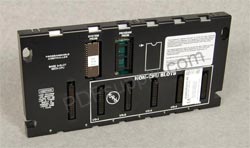GE Fanuc Series 90-70 CPUs Configuration

CPU – The heart and brains of any PLC system is the CPU. All PLCs require a CPU to function. In the Series 90-70 the CPU is modular and mounts right into the system rack. To properly configure a Series 90-70 system the engineer must survey the requirements and the intended results he expects from the PLC system he creates. Choosing the proper CPU to handle the various requirements necessitates surveying the machine documents, mechanical drawings, and specifications of the machinery being used and of the finished product expected. Here are the major considerations for the engineer in configuring a system to meet his needs and selecting the proper CPU:
- I/O Points – Determining the number of Input and Output points the system will require is the basic first step in configuring a PLC system. This determination will ultimately decide most of the equipment options to follow. Fewer I/O Points leaves the engineer with the option of choosing CPUs with less memory and capability. A high number of I/O Points will require selections of a CPU with greater capabilities, such as more memory and speed. The accompanying chart delineates the various CPU options to meet virtually all system requirements. The number of I/O Points also dictates the number of racks the system will require, the number and type of input and output modules needed, and even the number of power supplies required.
- I/O Modules – After the engineer has determined the number of I/O Points his system requires, he can then select the I/O Modules he will need to configure the system. Since there are a significant number of I/O Modules available, he will need to refer to the accompanying table to determine his needs. Some selection factors include:
- Voltage/Current – the Series 90-70 is capable of meeting all industrial voltage and current requirements. Considerations include AC/DC and 110V/120V or 240V. The answers to the voltage and current requirements also figure in selecting the power supplies to be used, as well as the I/O Modules.
- Isolation – Will the system components need to protected from harsh environments, such as automotive spray booths or extreme temperatures? What are the distances the system components will be separated? The accompanying table lists the various options based on these factors.
- Standardization – Does your company already use specific components to save on inventory, repair parts, and even training?
- Cost – As noted above, smaller numbers of I/O Points require less expensive systems. Also noteworthy is the capability of using higher volume modules instead of 2 or 3 lower volume ones, saving on both module and rack/power supply expenses.
- Communication and Specialty Modules – Determining the type of communication requirements, such as Ethernet or other networks, aids in selecting the proper modules required. Requirements for interfacing with machinery, such as CNC, need to be assessed. Also, such needs as motion control, high speed inputs, servo control, and the like must be determined to properly configure the system.
Having made all of these system determinations, the engineer can now proceed to CPU selection. Series 90-70 CPUs have many options available, such as memory size, speed, performance, and even enhanced software options. They all have TOD (time of day) clocks and are password protected, and all (except CPU731) have keylock protection. All of the CPUs available (except CPU731) have floating point math capabilities, enabling decimal point calculations and the use of trigonometric, logarithmic, exponential, and radian conversion factors. The highest performance CPUs available in the Series 90-70 use the state-of-the-art 486DX4 microprocessor, with redundant operations capability. The CPM790 is programmed with software for use in Emergency Shut Down (ESD), fire and gas, and other critical control operations, Comparing the various CPUs is easy with the following table:
| PART NUMBER | SPEED (MHz) | PROCESSOR | I/O POINTS (DISCRETE | I/O ANALOG | CPU MEMORY USER LOGIC RAM | USER FLASH MEMORY | FLOATING POINT MATH | SYSTEM |
| IC697CPU731 | 12 | 80C186 STANDARD | 512 | 8K | 32K | NO | NO | 32 BIT |
| IC697CPX772 | 96 | 80486DX4 STANDARD | 2048 | 8K | 512K | 256K | YES | 32 BIT |
| IC697CPX782 | 96 | 80486DX4 STANDARD | 12288 | 8K | 1MB SLOW | 256K | YES | 32 BIT |
| IC697CPX928 | 96 | 80486DX4 STANDARD | 12288 | 8K | 6MB MEDIUM | 256K | YES | 32 BIT |
| IC697CPX935 | 96 | 80486DX4 STANDARD | 12288 | 8K | 1MB FAST | 256K | YES | 32 BIT |
| IC697CGR772 | 96 | 80486DX4 REDUNDANT HOT SWAP STANDBY | 2048 | 8K | 512K | NO | YES | 32 BIT |
| IC697CGR935 | 96 | 80486DX4 REDUNDANT HOT SWAP STANDBY | 12288 | 8K | 1MB | NO | YES | 32 BIT |
| IC697CPM790 | 64 | 80486DX2 REDUNDANT HOT SWAP STANDBY | 12288 | 8K INPUT 8K OUTPUT | 1MB | NO | YES | 32 BIT |
Be sure to see the Technician's Dream Bundle
Click for PLC Programming Training
- Series 90-70 CPU Racks
- Series 90-70 Power Supplies
- Series 90-70 CPUs
- Series 90-70 Digital Input/Output Modules
- Series 90-70 Communications and Specialty Modules
